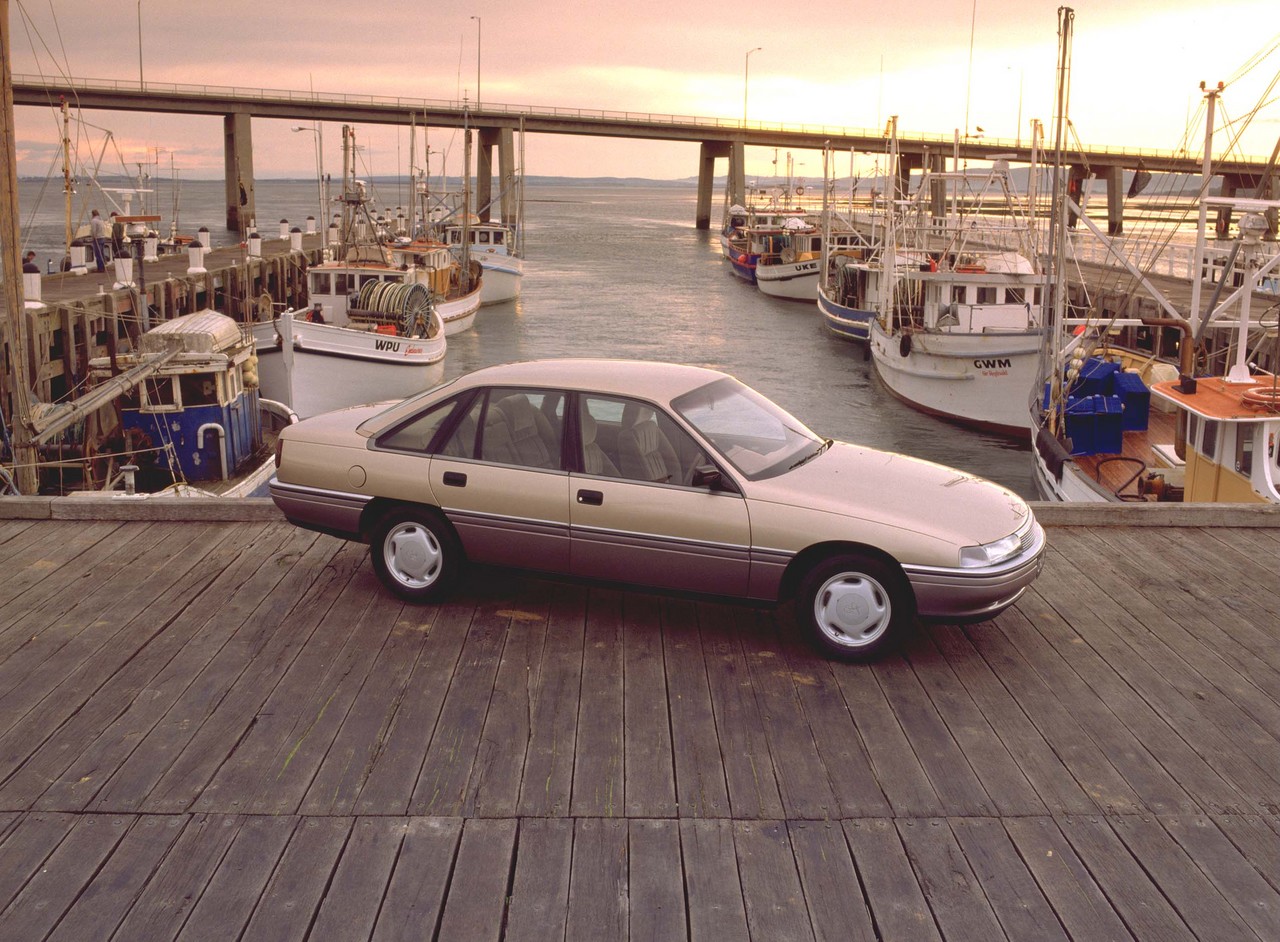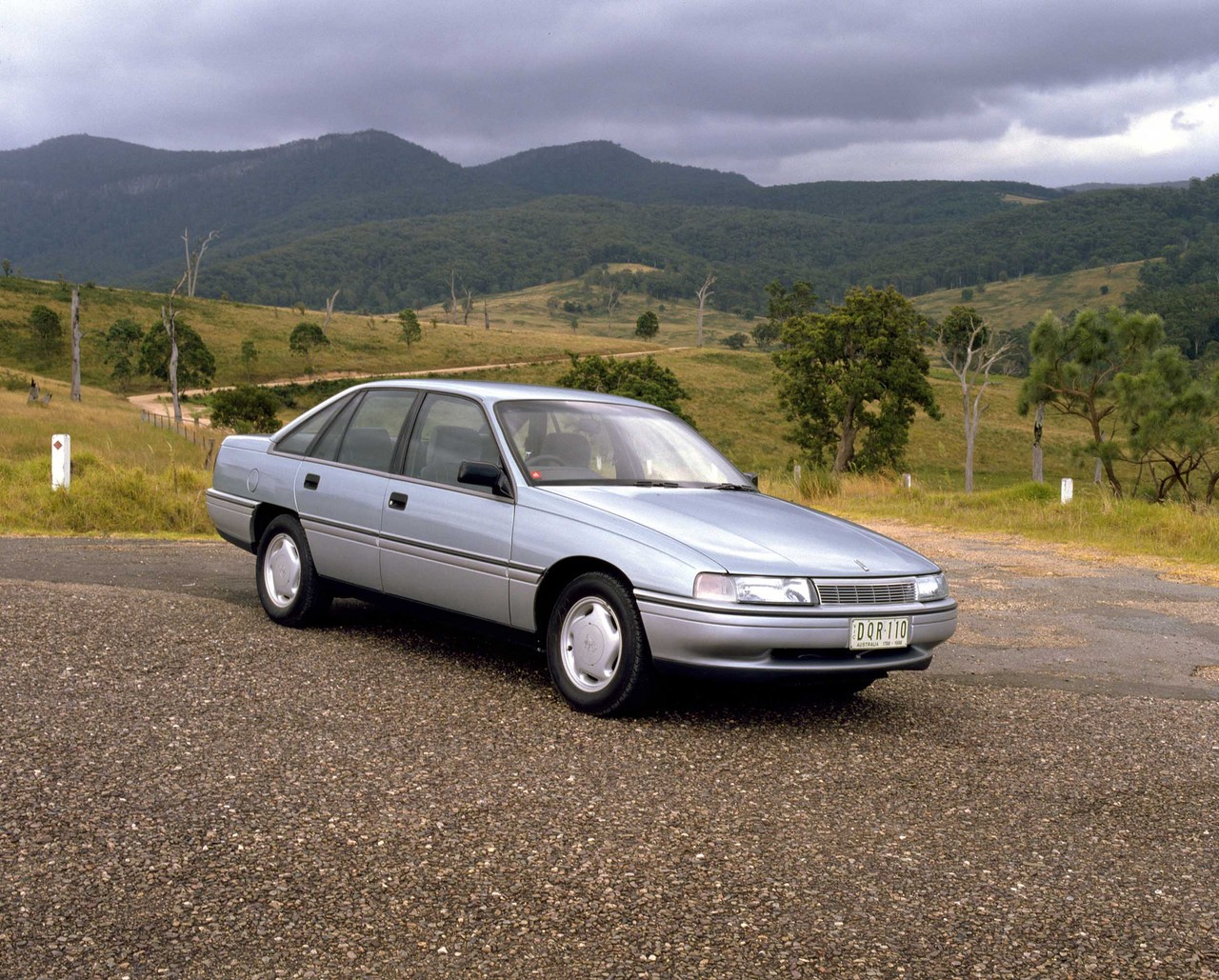
- V6 engine coarse above 3000 rpm
- Sensitive throttle
- Clunky downshifts for automatic transmission
- Poor standard of interior fit
- Basic live rear axle suspension
Overview
Released in August 1988, the Holden VN Calais was a large sedan. Manufactured in Elizabeth, South Australia, the rear-wheel drive VN Calais was initially available with a newly introduced 3.8-litre V6 engines. From March 1989, however, the Calais range was expanded with the introduction of 5.0-litre V8 engines which featured multi-point electronic fuel injection (EFI).
V6 and V8 engines
Initially imported but subsequently manufactured by Holden, the 3.8-litre LN3 (or HV6) pushrod V6 petrol engine had a cast iron block and cylinder head, multi-port fuel injection, two valves per cylinder, a single balance shaft, three coil-packs for ignition, a Delco electronic control module and a compression ratio of 8.5:1. In October 1989 and November 1990, however, the 3.8-litre V6 was upgraded (see ‘V6 engine upgrades’, below).
The 5.0-litre LB9 pushrod V8 engine had a cast iron block, two valves per cylinder, multi-point fuel injection, a Delco electronic control module and a compression ratio of 8.4:1. Compared to the V8 engine in its VL predecessor, the VN V8 had upgraded main bearings, stronger A9L connecting rods and ‘high port’ cylinder heads.
Transmissions
Both the V6 and V8 engines were available with new four-speed Turbo Hydramatic 700 R4 automatic and five-speed Borg-Warner T-5 manual transmissions. In October 1989, the internal components of the TH700 R4 transmission were upgraded and it was known as the Hydramatic 4L60.
V6 engine upgrades: October 1989 and November 1990
As noted above, the 3.8-litre V6 petrol engine underwent upgrades in October 1989 (sometimes referred to as ‘Series 1.5’) and November 1990 (‘Series 2’); for the latter, the code ‘EV6’ was printed on the engine block. The changes are as follows –
- October 1989 update:
- Introduction of moulded plastic rocker covers with revised seals and retainers;
- Single valve springs (previously double valve springs);
- Steel pushrod guide plate replaced by three alloy retainers with revised rocker arm pivots;
- For the camshaft, changes included decreased lobe lift, increased valve timing duration and installation of a thrust washer;
- For models with automatic transmissions, a retaining plate was fitted to the drive plate;
- The gasket between the pick-up pipe and the cylinder block was replaced by an ‘O’ ring and the direction arrow on top of the pistons was omitted;
- For the cooling system, a coolant reserve tank was installed, while an overflow hose and cap were fitted to the surge tank; and,
- During 1990, high flow hydraulic tappets were installed (identifiable by a yellow snap ring above the pushrod seat).
- November 1990 update (EV6, L27 )
- Redesigned inlet manifold;
- Bellmouth fitted to the throttle body;
- Cast iron exhaust manifolds introduced;
- Redesigned pistons;
- Revised coolant passages for the cylinder heads;
- Improved valve stem oil seals;
- Stainless steel welch plugs;
- Longer oil pressure regulator spring to increase oil pressure;
- Timing cover shield introduced to protect the crankshaft sensor;
- Press-fit crankshaft pulley introduced;
- Standardised crankshaft for models with automatic and manual transmissions; and,
- For the cooling system, the radiator had a conventional filler neck and radiator cap, while the surge tank was replaced by a reserve tank.
Dimensions
Compared to the VL Calais , the VN Calais sedan was 99 mm longer (at 4865 mm), 91 mm wider (1813 mm), 40 mm taller (1406 mm) and had a 63 mm longer wheelbase (2731 mm).
Suspension
The VN Calais had MacPherson strut front suspension with coil springs and a 26 mm stabiliser bar and a live rear axle with parallel short upper arms, long lower trailing arms, a Panhard rod (between the axle and underbody) and a 16 mm decoupled stabiliser bar. The optional FE2 sports suspension provided firmer springs, different stabiliser bars and a lower ride height.
| Engine | Years | Trans. | Peak power | Peak torque | |
|---|---|---|---|---|---|
| Calais | 3.8-litre LN3 petrol V6 | 1988-90 | 5sp man., 4sp auto |
125 kW at 4800 rpm | 292 Nm at 3200 rpm |
| 3.8-litre L27 petrol V6 | 1990-91 | 5sp man., 4sp auto |
127 kW at 4800 rpm | 288 Nm at 3200 rpm | |
| 5.0-litre petrol V8 | 1989-91 | 5sp man., 4sp auto |
165 kW at 4400 rpm | 385 Nm at 3600 rpm |
Brakes
The VN Calais had 289 mm by 22 mm front brake discs and 278 mm by 10.5 mm solid rear brake discs, both fitted with single piston calipers.
Features
Standard features for the VN Calais included 15-inch alloy wheels with 205/65 HR15 tyres, a four speaker sound system with a radio and cassette player, air conditioning, cruise control, soft velour seat fabrics, cut-pile carpets, remote central locking, power windows and mirrors, a height adjustable driver’s seat, power-operated boot release and trip computer.
In October 1989, standard features were extended to include climate control air conditioning and a Mongoose alarm system.
Related links




